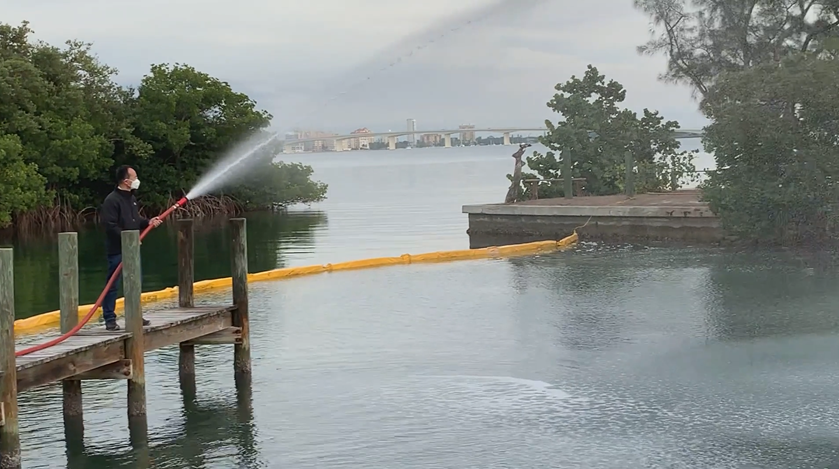Blooms of the toxic marine algae Karenia brevis, commonly known as red tide, occur almost annually on Florida’s west coast, often killing other marine life and costing local economies millions of dollars per outbreak. NCCOS-funded scientists have found that clay treatments may offer a way to control the blooms without harming one of the state’s most commercially valuable species — blue crabs.
In a process called clay flocculation, a solution of clay and seawater is sprayed over the water surface of an affected area. Clay particles then burst the algal cells and aggregate with the burst cells and their released toxins. These aggregates sink, clearing bloom biomass from the water and depositing on bottom sediments to be dispersed by natural currents.
Among the various options for bloom control, clay is appealing because it is inexpensive, easily scalable over large areas, and has low environmental impacts, as demonstrated by lab experiments and field applications in China and Korea. However, there have been few studies on the potential impacts to animals.

With that in mind, the researchers chose to investigate a bottom species that, in practice, would receive the sinking clay–algae aggregates. They also wanted to look at a species that is economically important for the state. In 2020 alone, commercial landings of blue crab in Florida were valued at over $13 million.
The team collected and transferred crabs from Sarasota Bay and Bird Key Park to seawater tanks at the Mote Marine Laboratory for experiments with clay and K. brevis. No crab mortalities occurred in the clay-treated Karenia tanks, and crab reflexes were not significantly different in clay-treated Karenia tanks compared to Karenia-only tanks. The findings suggest that clay to control red tide will likely not affect blue crab populations. The researchers plan to continue investigating the impacts of clay treatments on additional species to ensure clay is both safe and effective to mitigate red tide.
Historically, red tide management in Florida has focused on policies to reduce sources of nutrients that fuel blooms, rather than trying to suppress blooms as they are occurring. However, since the devastating bloom of 2018 — which affected over 150 miles of coast — the state of Florida has funded a collaborative program between the Florida Fish and Wildlife Conservation Commission and Mote Marine Laboratory to develop strategies and products that control blooms. The study presented here was funded by the new program (Florida Red Tide Mitigation and Technology Development Initiative) and the NCCOS Prevention, Control, and Mitigation of Harmful Algal Blooms Program.
